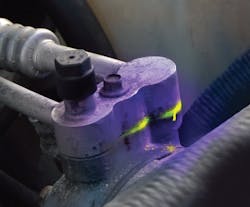When inspecting a truck’s heating, ventilation, and air conditioning (HVAC) system ahead of winter, some may prioritize the heating system over the A/C. Fleets want to keep their drivers happy, comfortable, and warm during the winter, so a functional heating system is imperative. Technicians need to consider, however, that having a well-maintained A/C system during the winter is just as important as the heating system.
Equally important to inspecting the entire HVAC system before temperatures drop is understanding what issues to look for and the tools and equipment necessary to handle those issues should they arise.
The importance of HVAC maintenance
The number-one reason for regularly inspecting and maintaining vehicle HVAC systems, though seemingly obvious, is “so the system actually works when you need it,” say Eberspacher’s John Dennehy, vice president of marketing and communications, and Tom Stencil, senior regional sales manager. Eberspacher is a system developer and supplier of exhaust technology, vehicle heaters, and bus air conditioning systems.
As with most mechanical components, the HVAC system works better the more often it is run. Dennehy and Stencil recommend that cab heaters or the engine coolant preheaters are run a minimum of 15 minutes at least once per month.
“This helps keep the fuel system primed, promotes cleaning of the inside of the heater combustion chamber, and most importantly, the heater works when you need it,” they say.
Though Dennehy and Stencil acknowledge that running the heater won’t help if an issue already exists, running the system regularly will likely alert fleets of any issues meaning maintenance can be performed before a complete system failure.
In addition to checking the heater, the A/C should also be tested.
“Some people are not aware of this, but when you turn on your defrost in the winter time, the A/C system also comes on to provide you a dry, warm air coming out of the defrost vents,” Dennehy and Stencil say. “This also helps the A/C system stay working because … it helps exercise the components of the A/C system.”
A properly functioning HVAC system is important for driver and passenger comfort and safety. The HVAC system helps to prevent moisture buildup on the truck’s windows, as well as defrost them, so the driver’s visibility is not impaired, explains Tim Wagaman, senior product manager at Bosch Automotive Service Solutions, a provider of diagnostic and repair shop equipment.
Wagaman also notes that a well-run HVAC system will help keep other systems within the truck running smoothly in cold weather.
Common HVAC issues
As fleets prep for the cold winter months, there are a variety of HVAC issues to keep an eye out for such as proper air flow, A/C leaks, the accumulator/drier becoming super-absorbed, and lost fuel prime. Most issues within the HVAC system can be avoided with preventive maintenance.
Air flow
“One of the first things to check should be your blend door, which is essentially a ‘door’ that opens and closes to direct which passages the warm or cool air flows through,” Wagaman says. “Cold weather can wear these parts out quickly, and they can impact how efficiently your cabin heats up.”
In order to check the blend door, Wagaman advises cycling the fan on each setting as well as checking all locations where air flows out to ensure there is enough air output through each blend door. This will help verify the system is functioning properly.
A/C leaks
A/C is an important part of the HVAC system year-round, so any A/C leaks could be potentially disastrous.
Jack Kelly, marketing strategist for Tracer Products, a supplier of OEM leak detection products, explains the difficulty with finding leaks as they can be very small. Pinhole leaks can range from 0.00001” to 0.0004” in diameter.
“[Leaks] are devastating because they create an ‘open system’ that lets refrigerant out and contaminants in,” no matter the size of the leak, Kelly says.
The longer a leak has been affecting the A/C system, the higher the probability of moisture having entered the system, which can cause damage to other vital parts. For instance, Kelly notes that moisture within the system enables mold and mildew to form and potentially interfere with normal operation.
Early detection is key. The earlier a leak is found, the less damage it can cause, and less money needs to be spent on repairs.
The best way to find leaks quickly and efficiently before they cause too much damage is using a blacklight with ultraviolet (UV) fluorescent dye, Kelly says. A technician can easily find the leak by examining where the UV dye fluoresces brightly when activated by a high-intensity light.
Super-absorption
In the winter, if the driver begins to notice an increase in humidity inside the cabin, this is likely due to the truck’s accumulator or dryer – depending on the A/C system’s design – being “super-absorbed,” says Brian Messenger, field service manager at Mahle, an automotive parts supplier.
Inside the accumulator or dryer is a desiccant bag that is designed to absorb residual moisture in the system, Messenger explains. Once the bag has reached its maximum capacity, the moisture cannot be absorbed so it circulates throughout the system, which increases the rate the refrigerant boils inside the evaporator. This then increases the low side pressure, meaning the evaporator’s surface temperature is greater than the 32 degrees F it is meant to be. The driver feels this as humidity in the cabin.
Messenger says an evacuation utilizing an EPA compliant recovery, recycle, recharge (RRR) machine is the only way to remove the moisture from the A/C system. This will not only prolong the life of the compressor, but also the lives of other components within the system.
Fuel prime
Another potential issue to watch for is the cab heater or coolant heater having lost its fuel prime, say Dennehy and Stencil. This can happen when heaters haven’t been run frequently enough. Fleets should advise their drivers to be patient when turning on the heat if it hasn’t been used in a while as the start cycle can take up to five minutes to complete.
HVAC maintenance
In addition to understanding what issues to look for within trucks’ HVAC systems, fleets must perform system maintenance. It’s better to stay ahead of problems than find them too late.
“The most beneficial thing you can do is a routine check by running through a checklist to make sure the system’s components are running correctly,” Bosch’s Wagaman says. “That list should include topping off all fluids, making sure that all blowers are working properly, and checking each blend door location to test for adequate air flow.”
Coupled with those checks, fleets should also look outside the HVAC system and check the engine cooling system for any issues. Mahle’s Messenger suggests technicians verify the thermostat and mechanical fan clutch or electric fans for the A/C condenser and radiator are efficiently operating, as well as check the radiator cap’s pressure rating and ensure there is no debris in the fins of the condenser and radiator. This promotes proper air flow for heat exchange and engine coolant integrity.
In order for a technician to fully maintain a vehicle’s HVAC system they must have the proper certification.
“EPA regulations stipulate that all vehicles requiring the removal of refrigerants be serviced by a certified technician under Section 609 of the Clean Air Act, and that all refrigerant be reclaimed and recycled,” say Michael Cicioni, HVAC application manager, and Ken Coventry, senior application technician for Webasto. Webasto is a manufacturer of custom heating, air conditioning, and sun roof solutions for a variety of applications, both OE and aftermarket.
Wagaman also recommends ASE’s training course on HVAC systems, which provides technicians information as well as a test to get them started on HVAC repairs and diagnosis. Furthermore, he notes there is OEM-level training available which addresses repairs for specific vehicle makes and models.
Armed with a checklist of components to test and training and certification to make repairs, the final items technicians need to maintain HVAC systems are the appropriate tools and equipment.
Wagaman suggests the following set of tools to assist with HVAC system maintenance:
- Diagnostic tool to pinpoint system issues
- Handheld leak detector
- Digital voltmeter
- Pressure tester
- RRR machine to assist with refilling HVAC system refrigerant
Refrigerant management systems (RMS) are another beneficial HVAC tool for technicians, Cicioni and Coventry note. The RMS setup gives technicians the ability to check pressures, recover refrigerant, and recharge the system.
With the proper tools and knowledge in hand, fleets can prevent many HVAC issues, avoiding future repairs and downtime.
Conclusion
When it comes to HVAC system winter preparation, fleets must inspect and perform any needed maintenance on the heating system as well as the A/C system. To do this, technicians need to have a full understanding of potential issues, training and certification to accurately diagnose and repair the system, and the necessary tools and equipment to provide any maintenance is needed.
About the Author
Emily Markham
Assistant Editor | Vehicle Repair Group
Emily Markham is an assistant editor for the Vehicle Repair Group.
With an education based in writing and editing, Markham uses her knowledge to assist with the creation of content for Endeavor Business Media Vehicle Repair Group’s publications—Fleet Maintenance, Professional Tool & Equipment News (PTEN), and Professional Distributor—as well as their website, VehicleServicePros.com.

